1. Definition
Sea transport is a method of transporting goods by ship across international and inland waterways. This is the most common solution for bulk, heavy or bulky items.
2. Outstanding Features
• Large shipping volume: Suitable for heavy, large-volume shipments such as raw materials, machinery, or consumer goods.
• Low cost: Transport prices per unit of volume are often lower than other methods such as aviation.
• Global connection: Direct links between major seaports around the world.
• Flexible time: Suitable for goods that do not require urgent shipping time.
3. Suitable Types of Goods
• Container goods (consumer goods, components).
• Liquid cargo (petroleum, chemicals).
• Bulk cargo (grain, coal, ore).
• Oversized goods (industrial machinery, construction equipment).
4. Advantages
• Economic efficiency: Transport large volumes at lower costs than by air or road.
• Sustainable: Lower greenhouse gas emissions per ton of cargo compared to other methods.
• Diversified services: Options such as FCL (Full Container Load) or LCL (Less than Container Load) shipping.
5. Disadvantages
• Long time: Slower than air transport, not suitable for goods that need to be delivered urgently.
• Weather dependence: Weather fluctuations can cause delays or affect goods.
• Complicated procedural requirements: Customs processes and import and export documents need time to process.
6. Shipping Process
1. Receive request: Receive information about goods type, volume and route.
2. Prepare goods: Pack and load goods into containers (if necessary).
3. Customs declaration: Carry out import and export procedures.
4. Shipping: Send goods to port and load onto ship.
5. Delivery: Unload the goods at the destination port and hand over to the recipient.
7. Current Trends
• Green logistics: Use clean fuel, reduce carbon emissions from ships.
• Seaport automation: Applying AI and IoT technology to manage goods faster and more effectively.
• International cooperation: Vietnam participates more deeply in free trade agreements to expand the shipping market.
8. Major Seaports in Vietnam
• Cai Mep - Thi Vai Port: The largest international transit point in the South.
• Hai Phong Port: Important logistics center in the North.
• Da Nang Port: Transport connection with ASEAN countries.
9. Reputable Service Provider
• International: Maersk Line, COSCO, Hapag-Lloyd.
• Domestic: Vinalines, Gemadept, Transime
Conclude
Sea transport plays an essential role in the global supply chain, especially for large import-export enterprises. With low costs, outstanding transport capacity and wide connection network, this is the ideal solution to optimize logistics. However, businesses need to carefully prepare procedures and time management to ensure operational efficiency.










